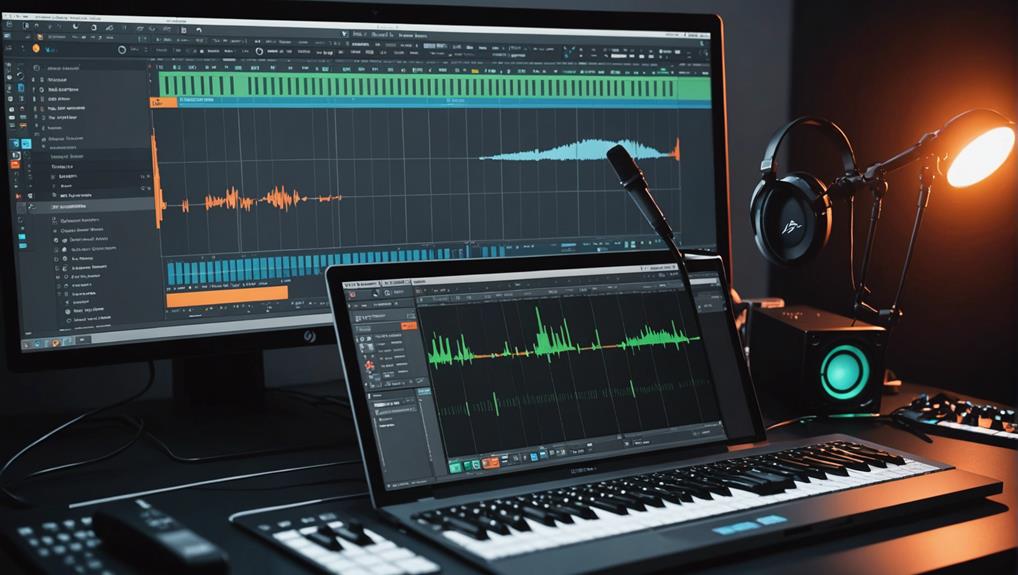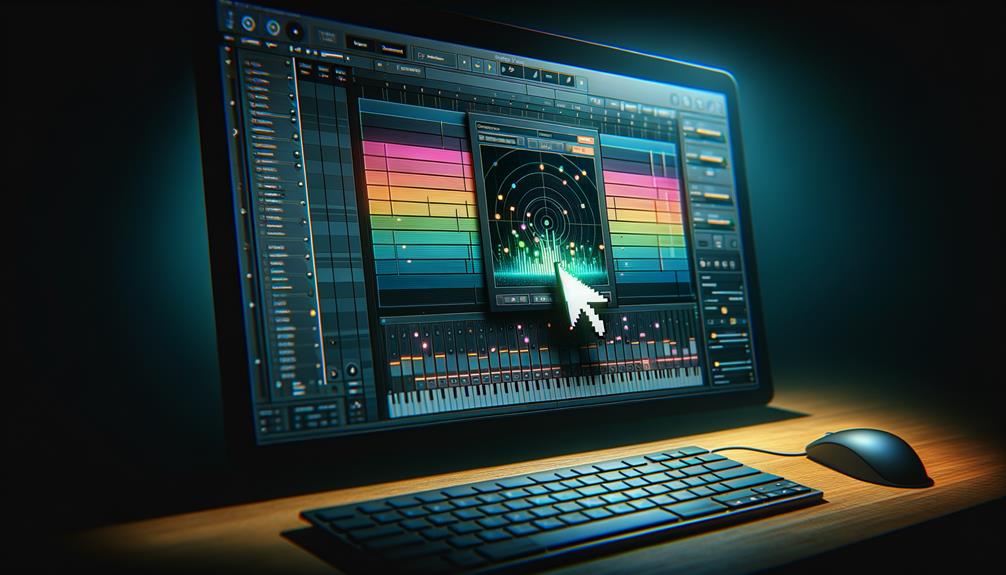To record pro-quality guitar tracks in FL Studio, start with reliable equipment like a Focusrite Scarlett Solo interface and quality cables by Mogami. Configuring FL Studio for peak input clarity is essential. Use the Edison tool for capturing and editing loops, ensuring tempo alignment for seamless integration. Enhance your tracks by applying effects such as EQ and reverb, and leverage guitar amp VSTs for diverse textures. Balance the mix through level adjustments and dynamic processing. Compare against professional tracks to meet industry standards. To explore further nuances in achieving professional-quality recordings, consider the subsequent detailed techniques and strategies.
Key Takeaways
- Use a reliable audio interface like Focusrite Scarlett Solo to ensure high-quality input/output.
- Set the correct tempo in FL Studio to seamlessly integrate guitar tracks.
- Capture and refine guitar loops using FL Studio’s Edison tool for precise editing.
- Balance mix by adjusting levels, panning, and using dynamic processing tools.
- Apply effects like EQ, reverb, and chorus for a balanced and rich mix.
Essential Gear and Setup
When preparing to record guitar in FL Studio, it is essential to select the appropriate gear and configure your setup correctly.
Begin with an affordable guitar, with reliable options available starting around $200, ensuring a solid instrument for recording. An audio interface, such as the Focusrite Scarlett Solo, is vital for capturing guitar sound effectively, offering high-quality input and output at a reasonable price.
High-quality guitar cables, like those from Mogami, are recommended to minimize white noise, costing approximately $80.
Configure FL Studio by setting up the Digital Audio Workstation (DAW) and ensuring the mixer recognizes your audio interface input. Activating the instrument button on the interface reduces noise, enhancing clarity in your recordings, paving the way for professional-quality tracks. Additionally, choosing an audio interface with low latency performance can significantly improve your recording experience by allowing real-time monitoring without delay.
Recording Process and Techniques
Initiate the recording process in FL Studio by meticulously setting the correct tempo, a critical step that guarantees the guitar track integrates seamlessly with the project’s rhythm.
Using FL Studio’s Edison tool, capture a rough draft of your guitar loop, facilitating precise trimming and editing post-recording. This initial loop serves as a foundation, allowing you to explore different sounds and freestyling solos to introduce unique elements and variations.
It’s essential to experiment with these improvisations to raise the composition. After recording, make certain to refine the loop by cutting it to the desired length for an ideal fit within the project’s context. This step enhances the cohesiveness and guarantees the recorded guitar aligns perfectly with the overall sonic environment, ensuring compatibility with plugin formats like VST and AU for added versatility in your production.
Adding Instruments and Effects
Following the recording and refinement of your guitar tracks, expanding the sonic scenery of your project involves strategically adding instruments and effects.
One thing to take into account is layering instruments such as piano, bass, or strings to enhance depth and richness. This creates a cohesive loop that captivates listeners.
Employing guitar amp VSTs like Archetype or alternatives such as Guitar Rig and Amplitube 5 allows exploration of diverse sound textures. Custom presets can be created within these VSTs for consistent sound and streamlined mixing in future projects.
Additionally, apply effects like EQ for frequency balance, reverb for spatial depth, and chorus for added richness. Using surgical EQ cuts can help remove resonant problem frequencies, ensuring the overall mix remains clear and balanced.
Experiment with melody integration to craft harmonies that enhance the loop’s engagement and dynamism.
Finalizing the Loop
In finalizing your loop within FL Studio, it is essential to balance all elements by adjusting levels and panning to achieve a clear and harmonious mix. Structuring the loop with distinct sections enhances clarity and maintains listener engagement throughout the arrangement. Continuously assess the overall quality by comparing your loop to professional reference tracks, ensuring it meets industry standards and identifying areas for refinement. Additionally, consider applying dynamic processing tools to enhance the consistency and polish of your mix.
Balance All Elements
Achieve a well-balanced mix by meticulously adjusting each instrument’s volume levels in the mixer, targeting a peak between -6dB and -3dB to prevent clipping while guaranteeing clarity.
Employ advanced mixing techniques such as frequency management to carve out distinct spaces for each element. Utilize EQ to address overlapping frequencies, particularly in the 200-500Hz range, to mitigate muddiness.
Implement dynamic range control through compression, applying a ratio of 3:1 to 4:1 to maintain consistent dynamics across your tracks.
Panning instruments within the stereo field, like placing rhythm guitars slightly left and right, enhances spatial depth.
Regularly reference professionally produced tracks to guarantee your mix’s competitive quality, ensuring all elements are cohesively balanced for a polished and professional loop.
Structure for Clarity
To guarantee a coherent and engaging musical composition, structuring your loop in FL Studio with clear sections such as the intro, verse, chorus, and outro is vital.
Employ loop organization techniques by utilizing markers to label these sections, facilitating seamless navigation and efficient editing. This method enhances the musical flow, allowing for intuitive section shifts.
Ascertain that each loop element complements the others by carefully balancing volume levels and adjusting panning, which yields a dynamic and cohesive sound.
Automation plays an important role in maintaining listener interest; apply it to parameters like volume and reverb to spotlight shifts.
Regularly review the arrangement by listening with other instruments, affirming clarity and cohesion throughout the loop’s finalized structure.
Assess Overall Quality
Evaluating the overall quality of your loop is essential to achieving a polished and professional sound. Begin by analyzing the frequency balance; guarantee each instrument occupies its space without overpowering others. Implement mixing techniques that compare your mix to reference tracks, identifying necessary adjustments in volume and EQ. Audio clarity is paramount; check the stereo imaging for appropriate panning, creating a balanced soundstage while maintaining focus on the main melody. Assess the dynamic range to prevent distortion in the loudest segments yet retain fullness throughout. Additionally, take regular breaks to refresh your auditory perception and spot potential inconsistencies.
| Aspect | Focus Area |
|---|---|
| Frequency Balance | Instrument Clarity |
| Mixing Techniques | Volume/EQ Adjustments |
| Audio Clarity | Stereo Imaging/Dynamics |
Audience Engagement Strategies
To optimize audience engagement when creating tutorials on recording guitar in FL Studio, it is essential to prioritize boosting social interaction and implementing an effective posting schedule.
Encouraging followers to interact through social media platforms, such as Instagram, enhances content visibility and fosters a community atmosphere.
Additionally, maintaining a consistent posting frequency of approximately two times per week can establish audience expectations and sustain interest over time. Incorporating user-generated content into your strategy can further strengthen community bonds and encourage active participation among followers.
Boosting Social Interaction
How can content creators effectively enhance audience engagement when teaching guitar recording in FL Studio? Utilizing social media engagement strategies such as interactive Instagram Stories that incorporate polls or quizzes can stimulate viewer feedback, allowing creators to tailor content to audience preferences.
Hosting live Q&A sessions on platforms like Facebook or YouTube fosters real-time interaction, addressing specific inquiries about FL Studio, thereby enhancing educational value.
Community building can be achieved by creating a dedicated hashtag for user-generated guitar recordings, promoting peer feedback and collaboration.
Additionally, incentivizing content sharing by offering shoutouts or featuring viewer work in tutorials enhances participation and recognition.
These techniques collectively foster a dynamic and engaged learning environment for guitar recording enthusiasts using FL Studio.
Effective Posting Schedule
When aiming to enhance audience engagement through an effective posting schedule, it is vital to contemplate the timing and frequency of content delivery.
Employing strategic posting frequency strategies, such as publishing two times per week on platforms like Instagram, can sustain interest and maximize interaction. Ideal timing is essential, necessitating a thorough analysis of when your audience is most active to guarantee content visibility.
Content planning should integrate short tutorial videos, offering viewers concise, valuable insights into the recording process. Encouraging feedback not only refines content strategy but also reinforces community engagement.
Incorporating music as a backdrop enriches the viewer’s experience, increasing shares and likes. Regularly tracking engagement metrics allows for refinement, ensuring the content continues to resonate effectively with the audience.
Content Creation Tips
Crafting compelling content for music production enthusiasts demands a strategic approach that balances technical insight with audience engagement.
Effective content creation strategies include producing concise, focused video tutorials on specific aspects of music production, such as recording techniques and effects application, ensuring viewers remain interested.
Implementing a consistent posting schedule, such as twice weekly on platforms like Instagram, enhances engagement by building anticipation.
Incorporating audience feedback is essential; encourage viewer interaction by inviting suggestions for future content to foster community.
Video aesthetics should maintain a cohesive and professional branding to solidify identity within the music production space.
Sharing behind-the-scenes content and music production snippets further augments audience connection, enriching the overall value of the content provided. Additionally, consider including tips on setting up your audio device to help beginners achieve better sound quality in their recordings.
Continuous Improvement
Consistently enhancing your guitar recording skills in FL Studio necessitates a methodical approach focused on experimentation and practice. Implement diverse practice techniques, such as adjusting EQ settings and exploring new effects, to uncover unique sounds. Utilize feedback loops with peers or online forums to refine your work and gain insights into potential areas for improvement. Tutorials and instructional videos can introduce advanced recording techniques, augmenting your creative arsenal. Goal setting is essential; delineate specific objectives for each session, like mastering a new effect or achieving a complex loop, to guarantee targeted progress. Regularly revisit your mixing process to achieve polished outcomes. This strategic framework fosters skill development and innovative production. Additionally, ensure your recording environment is conducive to capturing high-quality sound by minimizing background noise and optimizing your equipment setup.
| Practice Techniques | Feedback Loops |
|---|---|
| Experiment with EQ | Peer Reviews |
| Explore New Effects | Online Communities |
| Tutorials | Insightful Critiques |
| Goal Setting | Measurable Progress |
Frequently Asked Questions
How Do I Record Guitar Tracks in FL Studio?
To record guitar tracks in FL Studio, connect your guitar to an audio interface, ensuring ideal audio interface setup. Utilize FL Studio plugins like Edison for recording. Apply precise guitar recording techniques to capture high-quality sound, enhancing with effects.
How Do Pros Record Guitar?
Professionals achieve superior guitar tone through meticulous equipment setup and advanced recording techniques. They utilize high-quality audio interfaces, DAWs like FL Studio, and VSTs for amp simulation, prioritizing precise tuning and mixing to enhance sound quality.
Is FL Studio Good for Guitarists?
FL Studio is highly suitable for guitarists, offering extensive guitar effects, seamless audio interface connectivity, and robust MIDI integration. These capabilities facilitate precise tone shaping and efficient recording, ensuring professional-grade results for both novice and experienced guitarists.
How Do I Make My Guitar Sound Real in FL Studio?
Achieving realistic guitar tone in FL Studio involves utilizing advanced recording techniques and high-quality audio effects. Employ guitar amp VSTs, precise EQ adjustments, and reverb, while ensuring accurate tuning and ideal signal capture for professional-sounding tracks.
Conclusion
Achieving professional-quality guitar recordings in FL Studio requires a meticulous approach to gear selection, setup, and recording techniques. Incorporating additional instruments and effects can enhance the overall sound, while proper finalization of loops guarantees seamless integration within tracks. Engaging the audience effectively and employing strategic content creation are vital for reaching desired outcomes. Continuous improvement through analysis and adaptation is essential for maintaining high standards in audio production, assuring that each track meets professional benchmarks.



